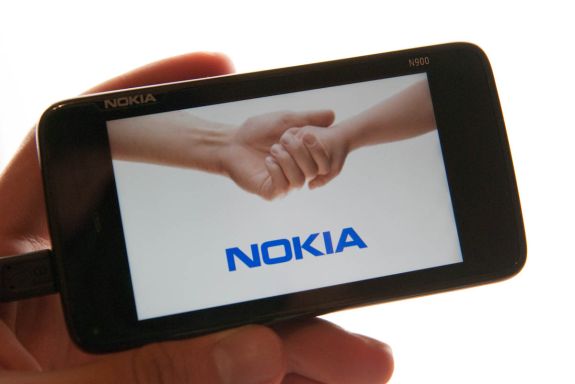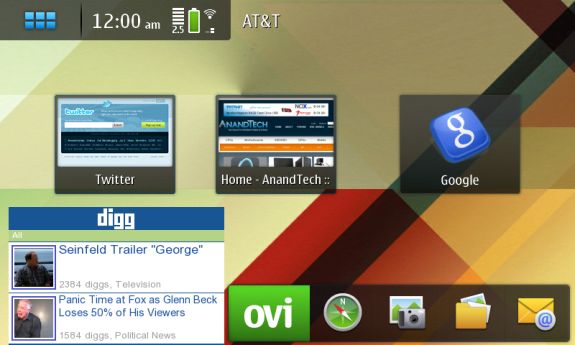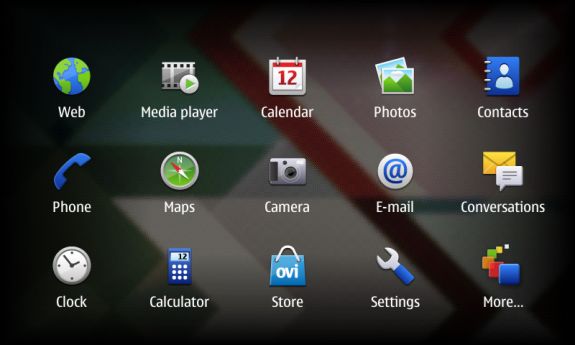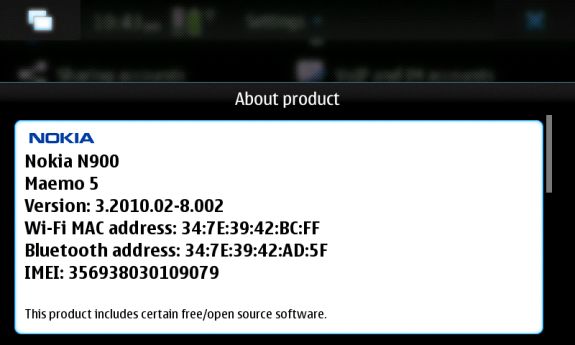Two OMAP 3430 Phones: Nokia N900 and Motorola Droid
by Brian Klug on June 10, 2010 9:29 PM EST- Posted in
- Smartphones
- N900
- Maemo
- Motorola Droid
- Droid
- MeeGo
- Android
- Mobile
Maemo is Debian
That really brings us to what we haven't talked in depth about before; Maemo. Nokia's Maemo operating system started - as I mentioned earlier - as a tablet operating system for the N770, and saw updates for the N800, and N810. As it stands now, all three legacy internet tablets can run up thorough Maemo 4.1.
The N900, however, launched with and continues to exclusively run Maemo 5. The N900 we played with was flashed to PR 1.1, and recently Nokia released PR 1.2 - unfortunately just a few days after we had to part ways with our N900. PR 1.2 brings bugfixes and a few new features to the platform, including support for Skype and Google Talk video calling (which I'll get to in a moment), performance increases for the core OS and browser JavaScript engine, and Qt 4.6.2. The core of the Maemo OS remains largely the same however.
Maemo is derived from Debian and runs natively compiled code, uses GNOME for much of the UI, has an X-Window system, and uses BusyBox core utilities. For all intents and purposes, using Maemo is exactly like using almost any other computer running Debian. What other phone seriously ships with X Terminal installed and presented front and center in the launcher? It really is a bona-fide handheld computer by day, smartphone by night.
In Maemo 5, up at the top is the menu and status bar. This is a bit of a strange departure for earlier Maemo users who likely are used to the same bar being at the left. Regardless, tapping on the icon at top left from the desktop brings up the application launcher, which consists of a 5 by 3 grid of applications overlaid on a beautiful defocused version of your desktop. What's really impressive is how buttery smooth the transition from desktop to launcher is; no doubt a huge testament to some GPU acceleration on the OMAP 3430's PowerVR SGX.
Getting to the next page of apps is unfortunately not a scroll gesture away, instead, you have to tap more in the bottom right corner. This is something that has changed in PR 1.2 however, as 'more' has been removed in favor of touch scrolling, and apps can be rearranged.
This out-of-focus blur is a consistent UI element that acts as Maemo's way of establishing what many on the desktop would identify as window 'focus.' Of course, in this context, it's more likely to be applied to a menu or some launched property panel.
For example, tapping and holding for a copy/paste or save file command brings up a blurry background surrounding the new property window. It's impressive how smooth this transition is, I just can't stress it enough.















68 Comments
View All Comments
DaveGirard - Saturday, June 12, 2010 - link
sweet Jesus, that Nokia phone is huge. Does it double as an ice cream sandwich cover?metafor - Sunday, June 13, 2010 - link
Cortex is the CPU designed by ARM. This is available as a hard-macro (layout already done) or soft-macro (just the functional RTL). Some companies license this in either version. For those who license the soft-version, such as TI, nVidia and Broadcom, they can do a customized place-and-route along with clock-tree optimizations and voltage partitioning to try to make the design run faster.However, the micro-architecture is the same.
A few companies have ARM architectural licenses (Apple, Qualcomm, Marvell) and instead of licensing the Cortex line of processors, they design their own. The micro-architecture is developed independent of what ARM did in their Cortex series albeit there will often be similarities.
Scorpion inside Snapdragon was developed in the course of years and while it has many similarities to the A8 from a power-point standpoint, the micro-architecture underneath was designed from the ground up. Everything from the branch predictors, the cache controller, exception handling, execution units and most notably, a partially OoOE scheduler and retirement buffer.
There's also the 128-bit, fully pipelined, partially OoOE SIMD/FP unit.
medi01 - Sunday, June 13, 2010 - link
Well, I find it very strange, that "incidentally" iPhone is never shown in bad light. Could you please update your side to side comparison?Impulses - Wednesday, June 16, 2010 - link
Personally I think there's better things for you guys to do or test with your time... Who cares if a phone's screen colors are more or less accurate, as long as they aren't outright flawed or ugly to look at it shouldn't be a big deal, not like anyone's gonna be doing any pro content editing work on their phones! (I don't even own an AMOLED screen so I'm not particularly biased one way or the other, I own an EVO atm)mojtabaalemi - Saturday, June 19, 2010 - link
I hate the design of nokia mobile phones . in my idea an iphone is far far better !paihuaizhe - Sunday, June 20, 2010 - link
(nike-alliance).(com)=>is a leading worldwide wholesaler company (or u can sayorganization)
arnavvdesai - Saturday, June 26, 2010 - link
I was just wondering if the author had installed AdBlock+ and then run the browser speed numbers or without it being on. If it was not installed which is what I am guessing from the photos, did you notice an improvement in the render times when it was installed. I actually bought the phone recently after seeing it on sale for 380$ and wanted to know the details. Also, I have heard that the current build of the OS allows potrait mode even for the browser(although it has to be activate through some setting) and not just the phone.drwiremore - Sunday, July 4, 2010 - link
Amanda, delighted to have found you. Given the issues in the title, affecting 20~50% of MOTO Droid users, was surprised to see no mention of it. The MOTO boards are alive with disdain and some feel an in you face attitude by Motorola Droid 2 and X announcements. Would you do an iPhone like analysis of voice, antenna and signal issues across Verizons Droids: HTC incredible and MOTO Droid. Your scientific analysis would be welcomed.